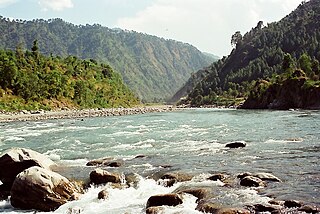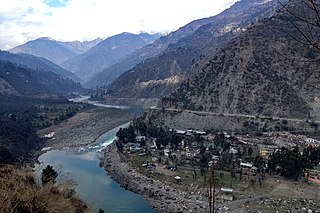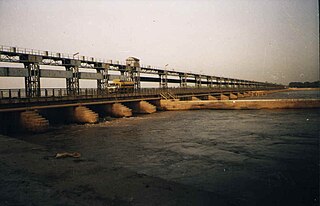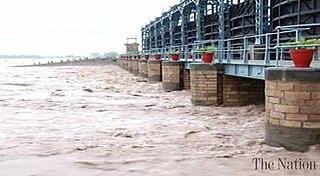
The Beas River is a river in north India. The river rises in the Himalayas in central Himachal Pradesh, India, and flows for some 470 kilometres (290 mi) to the Sutlej River in the Indian state of Punjab. Its total length is 470 kilometres (290 mi) and its drainage basin is 20,303 square kilometres (7,839 sq mi) large.

The Ravi River is a transboundary river crossing northwestern India and eastern Pakistan. It is one of five rivers associated with the Punjab region.

The Chenab River is a major river that flows in India and Pakistan, and is one of the 5 major rivers of the Punjab region. It is formed by the union of two headwaters, Chandra and Bhaga, which rise in the upper Himalayas in the Lahaul region of Himachal Pradesh, India. The Chenab flows through the Jammu region of Jammu and Kashmir, India into the plains of Punjab, Pakistan, before ultimately flowing into the Indus River.
The Indus Water Treaty (IWT) is a water-distribution treaty between India and Pakistan, arranged and negotiated by the World Bank, to use the water available in the Indus River and its tributaries. It was signed in Karachi on 19 September 1960 by then Indian Prime Minister Jawaharlal Nehru and then Pakistani president Ayub Khan.

Head Taunsa Barrage is a barrage on the River Indus in Taunsa district of Dera Ghazi Khan District, Punjab province of Pakistan. It is situated 20 kilometres southeast of Taunsa Sharif and 16 kilometres from district Kot Addu. This barrage controls water flow in the River Indus for irrigation and flood control purposes. Taunsa Barrage was designated a Ramsar site on 22 March 1996.

Trimmu Barrage is a barrage on the River Chenab in the Jhang District of the Punjab province of Pakistan. It is situated downstream of the confluence of the River Jhelum and River Chenab. It is situated some 25 km from the city of Jhang near the city of Atharan Hazari where the River Jhelum flows into the River Chenab. It was one of the 7 link canals to be built under the Indus Water Plan of Pakistan. Pakistan created this plan after Indus Water Treaty
The Lower Chenab Canal is a canal in Pakistan. It was dug in 1892 and originates from Khanki Headworks, which is situated on the River Chenab in Gujranwala District.

Marala Headworks is a headworks situated on the Chenab River near the city of Sialkot in Punjab, Pakistan. A weir was first built during 1906–1912 in British India to feed the Upper Chenab Canal, as part of the 'Triple Canals Project'. A new Marala Barrage was constructed in 1968 to feed the Marala–Ravi Link Canal in addition to the original Upper Chenab Canal.

The Islam Headworks, commonly known as Head Islam, is a headworks on the River Sutlej in Hasilpur Tehsil of the Punjab province of Pakistan. It is used for irrigation and flood control.
Rasul Barrage is a barrage on the River Jehlum between Jhelum District and Mandi Bahauddin District of the Punjab province of Pakistan. It is situated 72 km downstream of Mangla Dam.

A barrage is a type of low-head, diversion dam which consists of a number of large gates that can be opened or closed to control the amount of water passing through. This allows the structure to regulate and stabilize river water elevation upstream for use in irrigation and other systems. The gates are set between flanking piers which are responsible for supporting the water load of the pool created. The term barrage is borrowed from the French word "barrer" meaning "to bar".
Sulemanki Headworks is a headworks on the River Sutlej near Okara, in the Punjab province of Pakistan.
The Jinnah Barrage is a barrage on the River Indus near Kalabagh, Pakistan. It is part of the Thal Project which helps irrigate 770,000 ha in the Sindh Sagar Doab east of the Indus. Planning for the project dates back to the nineteenth century but final plans for the barrage were made in 1919 and it was constructed between 1939 and 1946. The barrage diverts an average of 283 m3/s (10,000 cu ft/s) of water into the 51.5 km (32.0 mi) long Thal Canal where it serves areas in Bhakkar, Khushab, Layyah, Mianwali and Muzaffargarh Districts with 3,362 km (2,089 mi) of additional canal branches and distributors. It has a maximum flood height of 8.5 m (28 ft) and it spans 1,152 m (3,780 ft) over the river. The barrage can discharge up to 27,000 m3/s (950,000 cu ft/s) downstream with 42 spillway gates which are each 18.2 m (60 ft) wide. Between 2006 and 2012, a 96 MW hydroelectric power station with four 12 MW pit turbine-generators was added on the right bank. In June 2012 a major rehabilitation project for the barrage began. The project includes the construction of a weir 244 m (801 ft) downstream to help dissipate energy from the spillway upstream of it. New guide banks will be built and existing ones repaired. The railway bridge upstream will be rehabilitated as well. The project is expected to be complete in June 2016.
Western Yamuna Canal is canal in river Yamuna that was dug out and renovated in 1335 CE by Firoz Shah Tughlaq. In 1750 CE, excessive silting caused it to stop flowing. The British raj undertook a three-year renovation in 1817 by Captain GR Blane of the Bengal Engineer Group. In 1832-33 Tajewala Barrage dam at Yamuna was also built to regulate the flow of water, and later Pathrala barrage at Dadupur and Somb river dam downstream of canal were constructed in 1875-76. In 1889-95 the largest branch of the canal Sirsa branch was constructed. The modern Hathni Kund Barrage was built in 1999 to handle the problem of silting to replace the older Tajewala Barrage.
Madhopur Headworks is a barrage on the Ravi River, just 14km from Pathankot city in Pathankot district in the Indian state of Punjab. It is located on the border with Jammu and Kashmir. The Upper Bari Doab Canal (UBDC) off-taking from Madhopur irrigates agricultural lands in Punjab and provides water to the cities of Pathankot, Gurdaspur, Batala and Amritsar.

Punjab Irrigation Department, Pakistan, is a provincial irrigation department in the Punjab province of Pakistan. Punjab Irrigation Department irrigates 21 million acres (8,500,000 ha) of agricultural land in Punjab. Rai Manzoor Nasir, Secretary to the government of the Punjab, is the administrative head of the department.

The Lower Bari Doab Canal is a canal in Punjab, Pakistan. Part of the part of the second-largest irrigation system of the province, it serves approximately 275,000 farmsteads. It is located south-west of Lahore and runs alongside the River Ravi.

Head Balloki or Balloki Headworks is a barrage on the Ravi River in the Punjab, Pakistan.it is 70 KM distance from Lahore. It was first built around in 1915 in British India as part of the 'Triple Canals Project' to feed the Lower Bari Doab Canal. The canal turned in a profit of 24% within ten years. The original weir has now been rebuilt as a full barrage.











